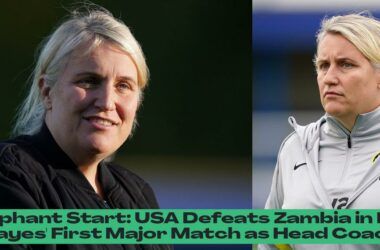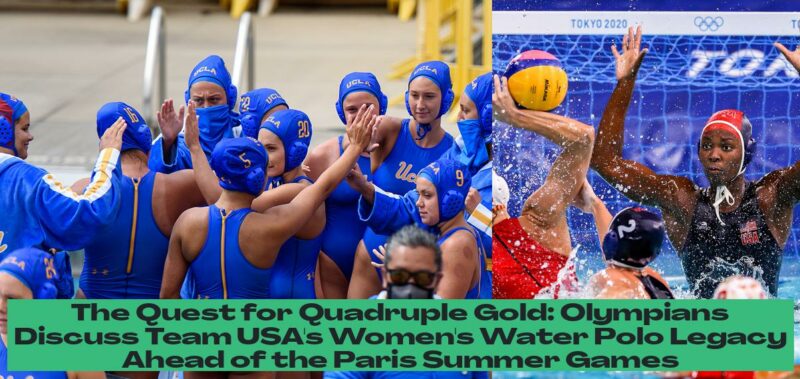A Legacy of Gold: Olympians Discuss the Women’s Water Polo Team Ahead of Paris
The roar of the crowd, the splash of the water, the fierce determination etched on every face – these are the hallmarks of Olympic water polo. And as the Paris Summer Games approach, the world’s eyes are fixated on one team in particular: Team USA’s women’s water polo squad. They’re not just aiming for a medal; they’re aiming for a historic feat. With three consecutive gold medals under their belt, they’re looking to become the first water polo team, men’s or women’s, to achieve a quadruple gold triumph.
But the road to Paris is paved with pressure. Two seasoned Olympians, Heather Moody and Rachel Scott Ruano, know this journey intimately. They’ve experienced the thrill of the Olympics firsthand, and they’ve witnessed the evolution of the women’s water polo team firsthand. They’re not just observers, they’re mentors, guiding the next generation of athletes towards their own Olympic dreams.
- Team USA’s women’s water polo squad is aiming for a historic quadruple gold triumph at the Paris Summer Games, seeking to become the first water polo team to achieve this feat.
- Experienced Olympians like Heather Moody and Rachel Scott Ruano are mentoring the next generation of athletes on the women’s water polo team, guiding them towards Olympic success.
- The women’s water polo team faces immense pressure due to their past successes, with other countries constantly aiming to dethrone them and achieve their own historic moments.
- The current team boasts a mix of seasoned veterans like Maggie Steffens and Ashley Grossman, providing strong leadership, along with younger players who are learning from the team’s rich history.
- Coach Adam Krikorian is praised for his leadership, with Olympian Heather Moody highlighting that the team is in good hands under his guidance.
- Olympian Rachel Scott Ruano emphasizes the importance of focusing on fundamentals even amidst the intense Olympic competition, urging younger players to stick to what they have practiced.
The Weight of History
Moody, who won silver in the 2000 Olympics and bronze in 2004, knows all about that pressure. “Since we’ve been at the Olympics, the women’s team has had a target on their back,” she explained. “Once you win that first one, and you’re competitive and undefeated for so long, the other countries are constantly aiming for you. It’s not just about the competition, it’s the pressure they put on themselves. They want to achieve that historic moment, and they have the drive to do it.”
The current team, with its blend of experienced veterans and hungry newcomers, is ready to face the challenge. “You have the returners, like Maggie Steffens, Ashley Grossman, and the Cage, who have that strong leadership,” Moody said. “Then you have the younger crew coming in, learning from that history. They have a great opportunity, and with Adam Krikorian at the helm, they’re in good hands. He does a great job.”
The Basics of Success
Ruano, who was an alternate for the 2000 team and an assistant coach in 2004, understands the mental game that goes hand-in-hand with Olympic competition. She urges the younger players to focus on the fundamentals, even amidst the Olympic frenzy. “It’s just like practice,” she says. “You work on the skills you’ve been practicing every day, and you implement them. It’s about showcasing what you’ve been working for. If you get caught up in the moment, you might get a little freaked out. It’s better to focus on the basics.”
The Olympic Games are a whirlwind of excitement, but Ruano emphasizes the importance of staying grounded. “Before some of our big games, we’d work on press defense, one pass away, two pass away. It’s elementary and basic, but so important.”
The Ripple Effect of Success
The success of the women’s water polo team has had a profound impact on the sport. “The sport itself is being televised more,” Moody says. “When we were playing, it was different. You reflect on the difference in technology, the way the sport is being viewed and promoted. It’s been part of the change. You have athletes who see the importance.”
Maggie Steffens, a current member of the team, embodies this new wave of water polo athletes. “She was young, her sister was on the Olympic team, and her dad was really into water polo,” Moody says. “She saw the importance of being a leader and having role models. She’s implemented that within the team. They emphasize the importance of being a role model for young athletes, showing them that they can achieve what they set their minds to.”
Gratitude and the Moment
Steffens’ emphasis on gratitude resonates with the team’s overall approach. “She understands the gratitude of what the sport is giving them,” Moody says. “They enjoy the moment.”
The women’s water polo team has a unique blend of experience, determination, and a spirit of gratitude. As they prepare for Paris, they carry not only their own aspirations but also the hopes of a generation of young athletes who see themselves in them. Their quest for a fourth gold isn’t just about winning; it’s about leaving a legacy that inspires generations to come.
Beyond the Pool: The Safety Debate in Paris
The Paris Olympics are bringing more than just athletic competition; they’re bringing a spotlight to the city’s iconic Seine River. The opening ceremony, the triathlon, and the open water swimming events are all scheduled to take place in the Seine. But this decision has sparked a debate about the river’s safety.
For over a century, swimming in the Seine has been banned due to concerns about E. coli and other health hazards. This ban has made the decision to host Olympic events in the river controversial.
A Mayor’s Plunge
In a bid to assuage concerns, the Mayor of Paris, Anne Hidalgo, took a bold step: she jumped into the Seine for a swim. “It’s very, very cool to be here,” Hidalgo said after her swim. “And it was a dream, and now it’s real.” She went on to say that after the Games, there would be a swimming pool in the river for Parisians and tourists.
The mayor’s swim was met with a mixed reaction. Some lauded it as a sign of confidence in the river’s safety. Others remained skeptical, pointing to the fact that the government had banned swimming in the Seine for so long.
The Critics’ Concerns
The decision to host events in the Seine has generated protests, with some people even pledging to put their waste in the river. They argue that the government shouldn’t be encouraging swimming in a river that has been deemed unsafe for so long.
The debate highlights the complexities of balancing environmental concerns with the desire to showcase a city’s unique features. The Paris Olympics will undoubtedly be a spectacle, but they also present an opportunity to address long-standing issues and to push for a healthier future for the Seine.
The Fashionable Side of the Games: Mongolia’s Traditional Attire Steals the Show
The Olympics are a celebration of athleticism, but they’re also a showcase of cultural diversity. And this year, Mongolia has stolen the show with its traditional attire.
The Mongolian team’s Olympic outfits have garnered rave reviews on social media. The outfits feature embroidered vests, pleated robes, and intricate accessories, all crafted with exquisite detail.
Contemporary Light
The company that designed the outfits calls them “contemporary light.” It takes 20 hours to handcraft each outfit, a testament to the dedication and artistry involved.
The Mongolian team’s attire is more than just fashion; it’s a tribute to their cultural heritage. It’s a reminder that the Olympics are a platform for athletes to represent not just their country but also the rich tapestry of traditions that makes them unique.









